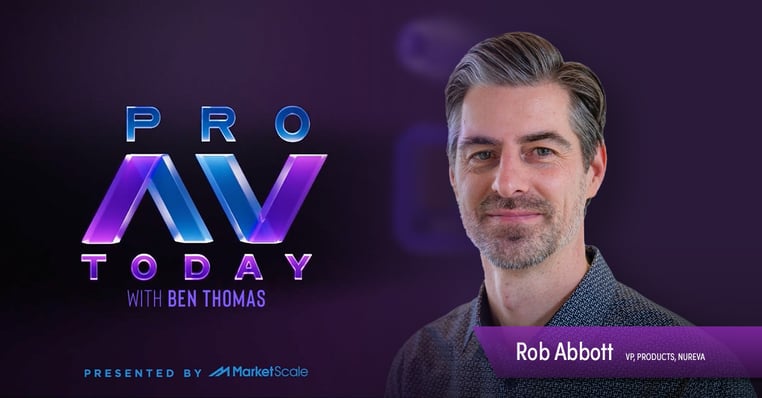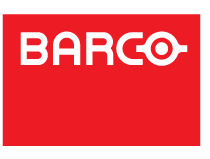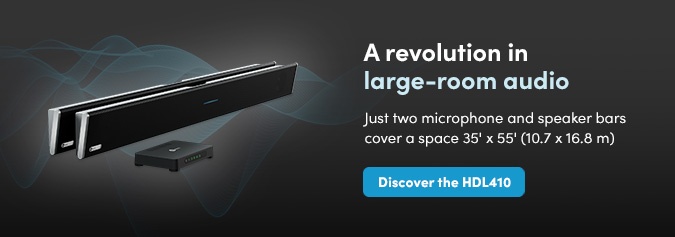Video podcast: Solving big-room audio can be simpler than you think

Posted by Dave McKean
In the post-pandemic hybrid era we’ve seen some significant changes in how meeting rooms are used, which affects how they are equipped. These factors, in turn, have implications for IT pros and how they do their jobs. In this episode of Pro AV Today, host Ben Thomas discusses these topics with Nureva VP, Products Rob Abbott. Rob tells us how Nureva’s large-room systems seamlessly adapt to different meeting and classroom scenarios, easily integrate with other conferencing technologies and provide the simplicity that makes for a better experience for IT and end users.
Timestamps
0:00 – Introduction
1:31 – Asking one space to do many things
4:03 – Getting simplicity and scalability for larger rooms
5:51 –What IT decision makers want today
9:51 – A new audio model for large spaces
11:46 – Integrating with multiple meeting technologies
Podcast transcription
Ben: Welcome back to Pro AV Today. It’s been an interesting year already. You’re seeing mandates from companies like Disney and Starbucks to have some level of return to office, but still maintaining their largely hybrid formats. And that introduces a challenge – especially for companies who have invested quite a bit in to technology for collaboration spaces and conference rooms during the pandemic. You’re seeing a lot of people coming back and needing huddle spaces and conference rooms. And the needs have grown. There are more people and there are more conversations happening. And there’s a company out there right now that’s doing quite a bit in this space and has a lot more knowledge about larger conference rooms than I do. And that company is Nureva. So I wanted to bring on somebody from Nureva and that is VP of products Rob Abbott. Rob, thanks so much for coming on the show today.
Rob: Thanks for having me. Happy New Year.
Ben: You as well. Just to set the table, you see announcements about things like RTO and modified hybrid work formats, and one of the challenges is that more people are now occupying some of these spaces that during the pandemic might not have been designed for that many people. Why are we seeing some of these challenges with meeting rooms and what are some of the ways you guys are responding?
Asking one space to do many things
Rob: The first thing that’s happening is that companies are realizing some of the things that were missing during the time everyone worked from home: the collaboration, the creativity – the things that come from getting everyone together. Some of those things are hard to replicate in a distributed session. And so the challenge they have is meeting rooms that weren’t necessarily designed for what they’re asking them to do now.
And they have the added challenge of going from zero to a hundred. You have days when there’s hardly anyone in the office and there are days where you’re encouraging almost everyone to show up. It’s the idea of having a town hall or a conference in your office – an “off-site on-site,” as I heard somewhere, which I think really encapsulates the challenge. If you really get down to it, you’re asking one single large space to do many things. It has to meet different use cases and very different kinds of attendee levels and collaboration approaches.
It’s a really challenging environment from a technology perspective because you need the flexibility to do multiple things like reconfigure spaces by moving the tables and chairs. And you have very different use cases as well. At its heart it’s the idea that with hybrid, things are a bit messy. It’s not just six people sitting around a conference room talking into a mic in the center of the table. It could be a workshop where you want to brainstorm. It could be a town hall where you want to mic one person. It might be a Q and A session. It’s very dynamic and flexible. That’s the core of the new challenges and opportunities that are in front of us.
Ben: You’re not only seeing these challenges with what I’ll call office collaboration spaces. It’s really transcending a number of different industries. I’m sure you’ve read that AMC and Zoom are partnering to utilize some movie theaters for large-scale collaboration. Things like that.
We’re seeing this idea of large-scale meetings expand beyond traditional office spaces. So the challenge becomes, how do you actually (and practically) mic everybody in the room and also make everybody visible? It’s incredibly difficult to do that. Rob, what are some of the ways that you’re seeing integrators, installers and designers meet some of these challenges?
Getting simplicity and scalability for larger rooms
Rob: From an integrator perspective, what I hear from them first is that they’re excited by the opportunity. It’s good for their business. There’s some complexity and challenge in these spaces they really like to get their hands dirty with.
But I think the heart of the challenge is that we’re used to a certain level of simplicity and scalability in small and medium-sized rooms. I think that’s what customers and integrators are looking for – extending that metaphor up into larger spaces. A lot of what they’re thinking about is how do I have this repeatable reference design? And so, although these rooms are bigger and they have acoustic challenges, layout challenges, physical challenges and more background noise and reverb (they’re just messier spaces), how do you take some of the lessons learned from the room kit mentality of smaller spaces and extend that up to larger spaces?
That’s why we’re working with our channel and our integrators on taking that reference design mentality and bringing it up into larger spaces – with the right level of integration so you can bring the best-of-breed pieces together. Customers want the best audio system with the best camera system with the best control system but in a way that is scalable without everything being customized. Customers don’t really tolerate that anymore. They want a certain cost and simplicity in what they’re trying to roll out.
Ben: Well, you talk about scalability and that’s when every IT manager and decision maker starts to perk up. Things like repeatability and scalability are at the forefront of the minds of a lot of IT decision makers who, frankly, the burden of outfitting a lot of these rooms falls on these days. Sticking with the enterprise office space, what are you seeing demand for from IT managers and decision makers in the market right now?
What IT decision makers want today
Rob: First, they want systems that are easy to install and set up. They don’t want systems that need tuning, tweaking or repeat visits from an “audio expert.” They want systems to be auto-configuring and auto-adjusting. It goes back to what we talked about before. IT managers know a room is going to change. They know that it might not just be a conference room. The table configurations might change. The number of people might change. The use case might change. So they just need a system that is intelligent enough and responsive enough to change without having any downtime.
It’s critical because, increasingly, IT departments are getting asked to do more with fewer people. IT staff budgets are staying pretty constant so having the same number of people managing a growing number of rooms is a real challenge. Which also means remote management with systems that let you peer into the health of a room from a central location is critical too. It used to be a nice-to-have, but I think it’s a must-have going forward. IT just doesn’t have enough people. And they need to go beyond just knowing whether a system is on or off, but also knowing if a room is healthy. It’s a very different problem. It’s one thing to say that MS Teams or Zoom will filter out the background noise for the remote participants, but what about the people in the room? What is their experience? It’s something where you need a different data set to determine.
They also want the assurance that the audio system being put in the room works really well with their UC&C platform of choice. It’s why we’ve seen a huge increase in the importance of certifications, room kitting and providing the validation that we’re working really closely with Microsoft® and Zoom. IT managers want that assurance.
Products for large rooms
Ben: Well Rob, it’s really easy in principle to say that in an ideal world, we would have everyone be able to be heard and seen in meetings or classrooms. But at Nureva you’re actually making strides to make that happen – especially in larger rooms. Talk to me about some of the products that you folks are rolling out at Nureva to actually accommodate those needs and make it scalable.
Rob: The center of what we do is looking at where there are problems in the market that haven’t been solved – places where we can add incremental value. If you look at huddle rooms and small rooms, there are a lot of ways they get a good experience. An IT manager has a whole range of choices, and they’ll get a pretty decent experience. So, at Nureva, we really set our minds to bigger spaces where active work happens. And regarding the point you made earlier, we didn’t know about COVID at that time and we didn’t think about, say, a movie theater as a target space, but it actually kind of led us logically to that place.
A different technology
So our team created a different technology, called Microphone Mist™, which is a very different approach from beamforming. It can give you full-room audio coverage in a space 35 feet by 55 feet with just two physical integrated mic and speaker bars that fill the space with over 16,000 virtual microphones.
We start with the scenario where everyone in that room needs to be heard, even if they’re standing at the edges of the room. But then we also think about a situation where you have a really large space, but sometimes you might want to just pick up just the front of room, as in an instructor-led session. Sometimes you might want to pick some other subset of the people in the room. So full-room audio coverage is our initial value prop, and then we narrow it down and add functionality on top of that.
A new audio model for large spaces
At ISE we’re highlighting a new model called the HDL410 which is a dual-bar system that connects through power over Ethernet to a connect module. And with these two bars you can get great consistent audio pickup in a room up to 35 feet by 55 feet. That’s your movie theater, your 150-person lecture hall, your large training room. It’s a very scalable model that also delivers on the desire for simplicity.
Ben: Well Rob, you bring up ISE and trade shows; it’s been interesting in the last few years how everybody’s been leaning towards video products like PTZs, webcam’s 4K mirrorless cameras, things like that. But now it feels like there’s been a shift back to enterprise audio. So I love hearing about the great work that you guys are doing to focus on the end user – the intelligibility, making sure that that meeting is not something where people leave confused. Maybe the meeting content is a little bit more confusing, but it’s not because people can’t be heard.
Sticking with the trade show topic, what excites you most not only about ISE but also shows like InfoComm and others throughout the rest of this year?
Rob: First of all, I’m excited to get out of the house and actually attend some of these things and talk to real people and dive into some things. But yes, ISE is a big event for us. We’ll be there full on at the end of January. And we’re back to normal in terms of the rest of our event schedule. Microsoft Ignite, Zoomtopia and the UC&C shows are important to us. And our IT manager customers are increasingly going to those types of shows.
Of course, InfoComm, EDUCAUSE and ISE are important, but we’re leaning a little bit more towards the smaller regional shows with our channel. We find you get a lot of really good customer interaction at the regional shows. But overall, we’re just excited to be back and talking to our customers.
Integrating with multiple meeting technologies
The other thing that we do at these events – and a big part of my role actually – is working with other companies. In large spaces you have multiple technologies, so we have a responsibility as a group of manufacturers to ensure that our systems work well together. You mentioned cameras – we put a lot of focus this year on providing a sound location API that allows PTZ cameras to ingest our sound location data from Microphone Mist and use that to more intelligently steer their cameras. That’s table stakes. If two pieces of technology are in the room together, they need to talk in a way that is modern – through modern APIs that are scalable. This is also true with Extron, and others like that, in terms of control. We just want to extend who we’re working with in this scalable, API-driven way. That means you’ll see a lot of discussions and announcements from us on how we’re working with other companies.
Ben: Well Rob, you talk about regional events and you talk about partnerships. I feel like we could have two separate episodes about those topics. We might have you back on the show to talk about in that in the future. We appreciate you coming on the show. Best of luck this trade show season.
Rob: Thank you very much, Ben, and hope to see you soon.

Posted by
Dave McKean
















